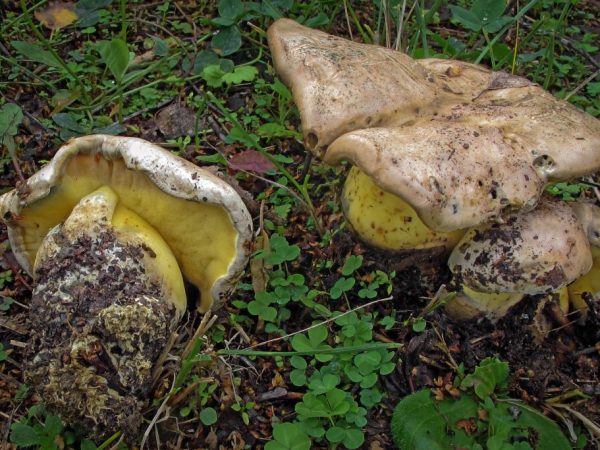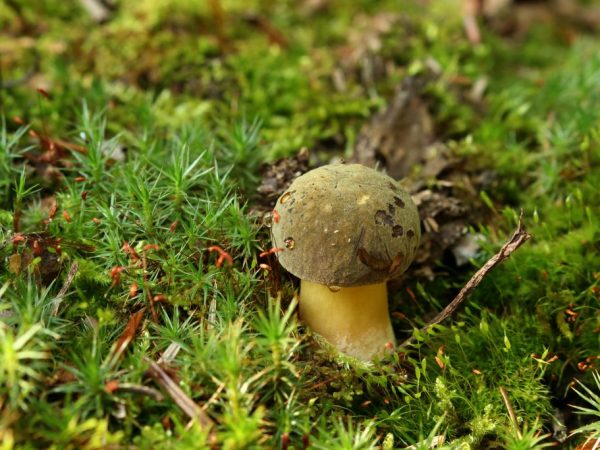Description of rooting boletus
Root boletus, or as it is also called stocky boletus, is an inedible type of boletus growing in coniferous and deciduous forests. He prefers acidic and sandy soils. It is not eaten because it has a bitter taste that cannot be eliminated even after prolonged heat treatment. This species bears fruit from July to October.

Description of rooting boletus
Mushroom species
The genus Boletus (Borovik) includes many both edible and inedible species, among which there are white, fine, bronze, beautiful-legged and other varieties. Both a rooted or whitish mushroom and species b. beautiful and b. lovely belong to inedible.
- Porcini: edible species. The color of the cap corresponds to the name, but it can also be dark. Its diameter can reach 26 cm in the presence of favorable conditions for development, its surface is dry and velvety to the touch. The pulp is light and dense, does not change color and does not have a smell. The leg is up to 18 cm long, has a cylindrical shape. The spore powder is brown-olive.
- Bronze boletus: refers to edible. The pulp softens with age, has a homogeneous structure, darkens noticeably on the cut, has a weak taste and aroma. The height of the leg is small.
- Semi-white mushroom, or yellow boletus: edible mushroom, the color of the pulp does not change on the cut. It has a characteristic, albeit mild, carbolic acid odor at the base of the stem. In diameter, the cap grows to 22 cm, the shape varies from rounded and convex to flat and rising.
- Boletus wonderful: species included in the inedible category. The diameter of the cap ranges from 8 to 30 cm, its shape is hemispherical, the surface is woolly. The color ranges from red to olive brown. The pulp is yellowish, noticeably blue on the cut. The height of the leg is up to 15 cm, its diameter is up to 7 cm maximum. The leg is rough to the touch, the base is covered with a small pile. This mushroom is used in cooking for pickling.
- Boletus boletus: representative of the group of inedible mushrooms. He has a light brown or brownish-olive upper part of the cap, its surface is wrinkled, the edge is wavy. The pulp is light and dense, turns blue when damaged. The tubules on the lower surface are yellow; on the cut they acquire a blue color. The length of the leg is up to 15 cm. This inedible mushroom grows on soils with high acidity, its upper part reaches 16 cm, the shape resembles a half of a ball, but it changes with age. The covering tissue is different to the touch. Its color is brownish-olive or brownish-gray. The leg is dense, towards the base it acquires a red tint.

The boletus has many edible and inedible species.
- Boletus wolf, or false satanic: it is classified as conditionally edible mushroom. It is characterized by a hat with a diameter of 10 to 20 cm. In young representatives, it is semicircular, with age it becomes prostrate. The covering tissue has a red or pink tint. Young specimens are light, with aging they noticeably darken within the limits of their color. The skin is dry, there is a felt coating on top.The pulp is light yellowish, which is also the stocky boletus, has a dense structure. The leg is cylindrical, only up to 8 cm long, therefore it is considered short. The surface of the leg is bright yellow and tapered at the bottom.
- Golden boletus: attributed to edible mushrooms, in the representatives of the species, the cap is somewhat smaller than in the above-described species, but its shape changes from convex to almost flat. At a young age, its skin is smooth and velvety; as it ages, it cracks noticeably. The hymenophore is also yellow tubules. The color hardly changes when touched. The length of the tubules is no more than 3 cm. The length of the stem reaches 25 cm, it is narrowed at the top. This part of the mushroom is thin and resilient, with a typical reticular pattern.
Description of rooting boletus
In rooted boletus, the cap grows to 4-26 cm in diameter and becomes hemispherical, which even later becomes somewhat convex and quite often its surface cracks finely. The structure is smooth and dry. Due to such a characteristic color of the cap (whitish, dirty gray or brownish gray), the mushroom is often confused with satanic. The edges of the cap are bent downward; with age, they straighten out, while maintaining waviness.
The lower surface of the rooting boletus cap is covered with spore tubes of yellow-lemon or yellow-olive color, which, if damaged, changes to yellowish and the surface of the tubes (pores) begins to turn blue. The same thing happens with the hat when touched.
- The height of the mushroom leg is 4 to 13 cm, while the diameter is 3 to 5 cm.
- The shape of the leg of the rooting boletus is cylindrical, there is an extension to the base.
- The leg is light lemon in color, in the lower part it is capable of becoming covered with olive-brown or bluish-green spots and a reticular pattern.
- The fleshy part of the rooting boletus is the same color as the leg: lemon or yellow. Turns blue on the cut.
Irina Selyutina (Biologist):
Root boletus is a mycorrhiza-forming agent and although it is found in the territory of mixed forests, it forms mycorrhiza only with representatives of deciduous tree species. Most often this happens with the participation of birch or oak. This is a rare species, although fruiting bodies can be found from summer to autumn. It is classified as an inedible mushroom due to its bitter taste. Biochemical studies have shown that there are no toxins in the pulp. But the bitter taste cannot be removed even by prolonged heat treatment. Therefore, among mushroom pickers rooted boletus received its "specific name" - "spongy boletus".
The boletus does not possess a pronounced aroma.
Growing places
Boletus needs a warm climate and a predominantly deciduous forest, dominated by oaks and birch groves. In rare cases, it can be found in mixed forests or conifers, where they are practically not found. These mushrooms prefer dry, neutral or calcareous soils.
Places where this representative is often found are North American European and African countries. Boletus bears fruit from July to October.
Conclusion
Rooting boletus is an inedible mushroom. It is not used in medical or culinary practice. As such, the variety does not represent value. Representatives of the species are characterized by the presence of many similar boletus species.



